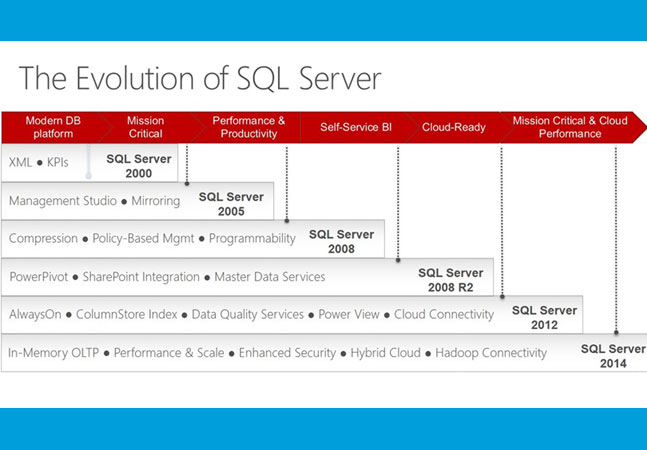News
Microsoft RTMs SQL Server 2014
Windows Azure HDInsight was also released, based on Hadoop 2.2.
No fooling: The next version of Microsoft's flagship database will be available on April 1.
SQL Server 2014 hit its "release-to-manufacturing" milestone today, which typically falls several weeks before the official unveiling.
The new relational database management system refines technologies available in the current SQL Server 2012 release, particularly in-memory column store index technology code-named "Hekaton," which now supports online transactional processing (OLTP). The technology enables "up to 30-times [the] performance gains," according to Microsoft's literature. Microsoft is also stressing scalability improvements in conjunction with Windows Azure via AlwaysOn technology. AlwaysOn is a SQL Server 2012 technology that enables databases to be failed over to other SQL Server installations, typically for high availability and disaster recovery scenarios.
Cloud Support
Part of today's news is about support for so-called "hybrid" scenarios, or using Windows Azure cloud computing infrastructure in conjunction with SQL Server 2014 on premises. For instance, Microsoft plans to roll out the ability to run SQL Server 2014 in a Windows Azure Virtual Machine on April 1, and this virtualized instance of SQL Server 2014 can act as "an additional secondary to your AlwaysOn solution," according to Microsoft's announcement. Quentin Clark, Microsoft's corporate vice president of the data platform group, described that capability as "a turnkey solution" that can be set up in "a few minutes," according to a released statement.
While Microsoft released its SQL Server Backup Service on Windows Azure in October, it's planning to release a standalone tool, called the "SQL Server Backup to Windows Azure Tool," on April 1. This tool will add support for older versions of SQL Server (from SQL Server 2005 onward), enabling those servers to tap the SQL Server Backup Service on Windows Azure. Microsoft is calling this April 1 release of the standalone tool the "general availability" release.
Also today, Microsoft announced the general availability release of Windows Azure HDInsight, although it had announced that service back in October. Windows Azure HDInsight is Microsoft's "big data" Hadoop-based solution, and it's now based on the Hadoop 2.2 platform. It includes support for Apache Hadoop YARN, which is the "data operating system" of Hadoop, as well as Stinger, which speeds up Apache Hive queries using SQL terms.
SQL Server 2014 Roadmap
Microsoft's changes in SQL Server 2014 mostly seem like refinements to the current product. Exactly how Microsoft sees this new release is illustrated in this TechEd slide, which shows Microsoft adding in-memory OLTP, performance and scalability improvements, security, hybrid cloud support, and Hadoop connectivity:
 Microsoft's SQL Server evolution.
Microsoft's SQL Server evolution.
Microsoft is claiming a five-times data compression improvement in its in-memory column-store index technology in SQL Server 2014. Buffer extension support was added for solid-state drives to enable "faster paging." SQL Server 2014 also has support for up to eight readable secondaries with AlwaysOn technology.
The engineering team focused on making this SQL Server 2014 release "100-times faster," according to Paul Larson, a principal researcher at Microsoft, in a Microsoft-produced Channel 9 interview. That led to rethinking the database management system's architecture, including integrating the Hekaton engine into the server. Larson described Hekaton as the main memory database engine that's scaled to hundreds of processes. It's designed to surmount the performance problems that database systems have with locks on data by putting everything in memory.
Microsoft's plans for SQL Server 2014 evolved because of underlying hardware changes, Larson explained. New hardware was enabling machines with large memories and lots of cores. Today, Microsoft's Hekaton technology is being used for applications such as real-time inventory analysis, gaming, stock trading and fast ingestion of data, he said.
In the same Channel 9 interview, Mike Zwilling, principal architect for SQL Server, said that Microsoft designed its new system to work with existing SQL Server workloads. SQL Server 2014 can be tapped to add in-memory support for the workloads that need to scale.
About the Author
Kurt Mackie is senior news producer for 1105 Media's Converge360 group.